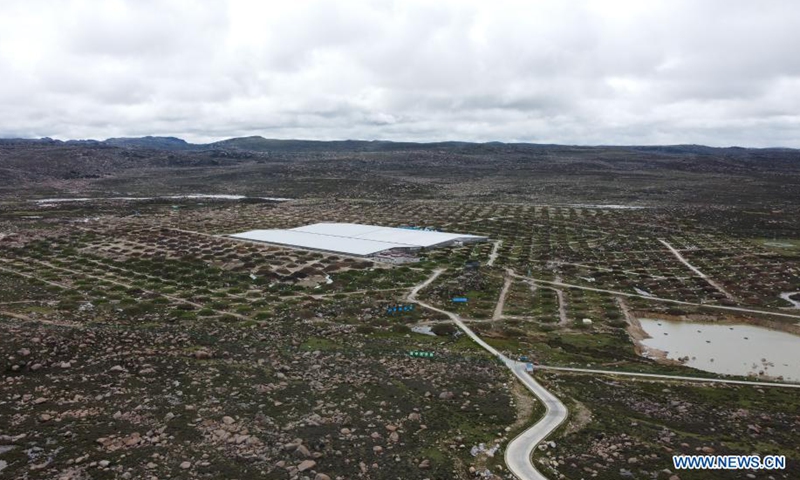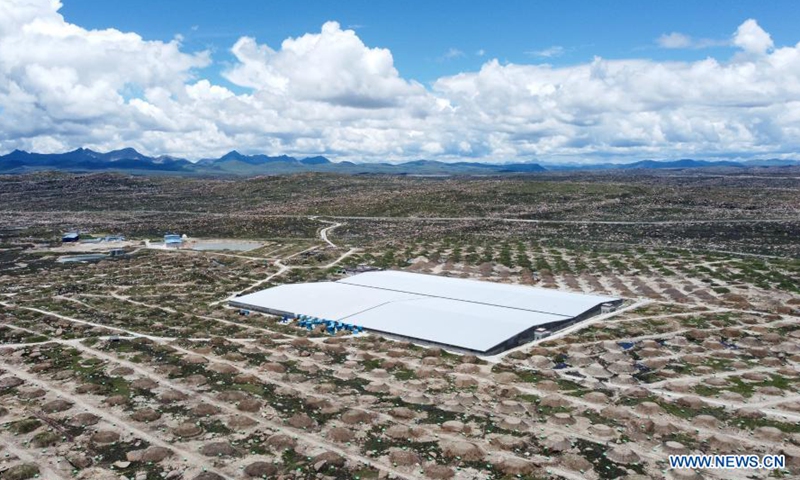By Global Times
Published: Jul 10, 2021

China's Large High Altitude Air Shower Observatory (LHAASO) is pictured in Daocheng, southwest China's Sichuan Province on July 8, 2021. Based on the observations of China's LHAASO, one of the country's key national science and technology infrastructure facilities, Chinese scientists have measured the brightness of the standard candle in high-energy astronomy.Photo:Xinhua

China's Large High Altitude Air Shower Observatory (LHAASO) is pictured in Daocheng,
southwest China's Sichuan Province on July 6, 2021.Photo:Xinhua

China's Large High Altitude Air Shower Observatory (LHAASO) is pictured in Daocheng,
southwest China's Sichuan Province on July 6, 2021.Photo:Xinhua

Cao Zhen, chief scientist of China's Large High Altitude Air Shower Observatory (LHAASO),poses for a photo with the sand table of LHAASO at the Institute of High Energy Physics (IHEP)
under the Chinese Academy of Sciences (CAS), Feb. 23, 2021.Photo:Xinhua
Nearly 1,000 years after ancient Chinese stargazers discovered a supernova, Chinese scientists have made a new discovery challenging classical physical theories. Their observation of the Crab Nebula, the remnant of an exploding star, indicates it could contain a super-powerful electron accelerator.
The Crab Nebula, 6,500 light-years from Earth, was created in a bright supernova explosion in 1054 A.D. and recorded by the imperial astronomers of China's Northern Song Dynasty (960-1127). It is the first supernova remnant identified by modern astronomy that has a clear historical record.

The Crab Nebula is one of few sources that has been measured in all energy bands including radio, infrared, optical, ultraviolet, X-ray and gamma-ray. Its spectrum has been extensively studied for decades by many observers. As a bright and stable high-energy source, the Crab Nebula is regarded as the standard candle by scientists.
Based on the observations of China's Large High Altitude Air Shower Observatory (LHAASO), one of the country's key national science and technology infrastructure facilities, Chinese scientists have measured the brightness of the standard candle in high-energy astronomy.
They achieved an accurate measurement in the ultra-high energy band from 0.3 to 1.1 PeV (1 PeV is equivalent to one quadrillion electronvolts) for the first time, thus calibrating the brightness of the standard candle over an unprecedented energy range.
Scientists have also detected a photon with an energy of 1.1 PeV, indicating the presence of an extremely powerful electron accelerator about one-tenth the size of the solar system in the core region of the Crab Nebula.
The accelerator can energize electrons to a level 20,000 times greater than the largest human-made electron accelerator on Earth could ever achieve, thus approaching the absolute theoretical limit posed by classical electrodynamics and ideal magnetohydrodynamics, said Cao Zhen, chief scientist of LHAASO.
"In 1054, the imperial astronomers of China's Northern Song Dynasty witnessed a supernova explosion. About 967 years on, a new observation of the supernova remnant by LHAASO has amazed us again," said Cao.
LHAASO, covering an area of 1.36 square km and still under construction at 4,410 meters above sea level in Daocheng County, southwest China's Sichuan Province, is expected to be completed by the end of July and subsequently put into full operation.
Scientists expect to detect one to two photons with energies of approximately 1 PeV in the Crab Nebula every year, so the puzzle of the cosmic PeV electron accelerator will be unraveled in the coming years, Cao added.
The study, led by the Institute of High Energy Physics under the Chinese Academy of Sciences, was published in the latest edition of Science.

China's Large High Altitude Air Shower Observatory (LHAASO) is pictured in Daocheng, southwest China's Sichuan Province on July 8, 2021. Based on the observations of China's LHAASO, one of the country's key national science and technology infrastructure facilities, Chinese scientists have measured the brightness of the standard candle in high-energy astronomy.Photo:Xinhua

China's Large High Altitude Air Shower Observatory (LHAASO) is pictured in Daocheng,
southwest China's Sichuan Province on July 6, 2021.Photo:Xinhua

China's Large High Altitude Air Shower Observatory (LHAASO) is pictured in Daocheng,
southwest China's Sichuan Province on July 6, 2021.Photo:Xinhua

Cao Zhen, chief scientist of China's Large High Altitude Air Shower Observatory (LHAASO),poses for a photo with the sand table of LHAASO at the Institute of High Energy Physics (IHEP)
under the Chinese Academy of Sciences (CAS), Feb. 23, 2021.Photo:Xinhua
Nearly 1,000 years after ancient Chinese stargazers discovered a supernova, Chinese scientists have made a new discovery challenging classical physical theories. Their observation of the Crab Nebula, the remnant of an exploding star, indicates it could contain a super-powerful electron accelerator.
The Crab Nebula, 6,500 light-years from Earth, was created in a bright supernova explosion in 1054 A.D. and recorded by the imperial astronomers of China's Northern Song Dynasty (960-1127). It is the first supernova remnant identified by modern astronomy that has a clear historical record.

The Crab Nebula is one of few sources that has been measured in all energy bands including radio, infrared, optical, ultraviolet, X-ray and gamma-ray. Its spectrum has been extensively studied for decades by many observers. As a bright and stable high-energy source, the Crab Nebula is regarded as the standard candle by scientists.
Based on the observations of China's Large High Altitude Air Shower Observatory (LHAASO), one of the country's key national science and technology infrastructure facilities, Chinese scientists have measured the brightness of the standard candle in high-energy astronomy.
They achieved an accurate measurement in the ultra-high energy band from 0.3 to 1.1 PeV (1 PeV is equivalent to one quadrillion electronvolts) for the first time, thus calibrating the brightness of the standard candle over an unprecedented energy range.
Scientists have also detected a photon with an energy of 1.1 PeV, indicating the presence of an extremely powerful electron accelerator about one-tenth the size of the solar system in the core region of the Crab Nebula.
The accelerator can energize electrons to a level 20,000 times greater than the largest human-made electron accelerator on Earth could ever achieve, thus approaching the absolute theoretical limit posed by classical electrodynamics and ideal magnetohydrodynamics, said Cao Zhen, chief scientist of LHAASO.
"In 1054, the imperial astronomers of China's Northern Song Dynasty witnessed a supernova explosion. About 967 years on, a new observation of the supernova remnant by LHAASO has amazed us again," said Cao.
LHAASO, covering an area of 1.36 square km and still under construction at 4,410 meters above sea level in Daocheng County, southwest China's Sichuan Province, is expected to be completed by the end of July and subsequently put into full operation.
Scientists expect to detect one to two photons with energies of approximately 1 PeV in the Crab Nebula every year, so the puzzle of the cosmic PeV electron accelerator will be unraveled in the coming years, Cao added.
The study, led by the Institute of High Energy Physics under the Chinese Academy of Sciences, was published in the latest edition of Science.
No comments:
Post a Comment